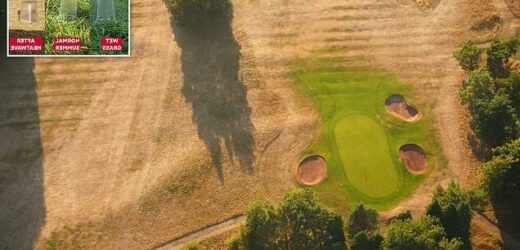‘Be careful’ about wishing for rain! Flash FLOODS could occur if heavy downpours follow the UK heatwave, expert warns
- A meteorology professor posted a video of an experiment on Twitter
- He used three glasses of water on different grass surfaces
- On wet and normal grass, water is quickly absorbed into the soil
- But when the soil is baked hard, the water sits on the surface and isn’t absorbed
- ‘If you’re praying for rain, you should pray for two days of drizzle, as dreadful as that sounds,’ the expert explained
With large parts of England set to be officially declared in a state of drought today, many Britons will be hoping for heavy downpours of rain.
But a meteorology professor has warned that people should ‘be careful’ about what they wish for.
Professor Rob Thompson, who is part of the University of Reading’s meteorology department, warns that flash floods could occur if heavy downpours follow the UK heatwave.
‘If you’re praying for rain, you should pray for two days of drizzle, as dreadful as that sounds,’ Professor Thompson explained.
Professor Thompson posted a video of an experiment on Twitter which used three glasses of water on different grass surfaces to demonstrate what happens when it rains after a drought
Why could flash floods occur?
Very dry and hot periods can bake the soil hard.
This means that if it rains, the water can’t soak into the soil easily.
Instead, most of it just runs straight off the surface, which can quickly turn into flash floods.
‘If you’re praying for rain, you should pray for two days of drizzle, as dreadful as that sounds,’ Professor Thompson explained.
Professor Thompson posted a video of an experiment on Twitter which used three glasses of water on different grass surfaces to demonstrate what happens when it rains after a drought.
In the first experiment, a glass of water is put on top of wet grass and rapidly soaks into the ground, with the second experiment highlighting that water soaks into grass during a normal summer at a slower pace.
In the final experiment, the water is placed on to what appears to be dry grass and does not seem to budge, highlighting the potential for flash floods to occur if heavy rain follows a heatwave.
Dr Thompson said: ‘Britain desperately needs rain to break this drought.
‘But we should be careful what we wish for.
‘Experience around the world has shown what can happen when heavy rain follows a very dry and hot period that has baked the soil hard.
‘The water can’t soak in easily, most of it just runs straight off the surface, which can quickly turn into flash floods.
‘If you’re praying for rain, you should pray for two days of drizzle, as dreadful as that sounds.’
The Met Office retweeted the post and added: ‘Dry ground takes more time to soak up water following a #heatwave than if it were during a normal summer.
‘This experiment shows how heavy rainfall following an extended period of extreme heat could lead to flooding.’
Temperatures have continued to soar across the UK and a drought is expected to be declared for some parts of England.
The National Drought Group – made up of Government and agency officials, water companies and other groups such as the National Farmers’ Union – is set to meet on Friday to discuss the prolonged dry weather.
There are expectations drought could be declared for the most affected areas of England in the south and east, after the driest July on record for some areas and the driest first half of the year since 1976.
Q&A: WHAT YOU NEED TO KNOW ABOUT DROUGHTS
Who decides if it’s a drought?
The Environment Agency’s National Drought Group declares when there is a drought. The group is made up of powerbrokers in the water sector with representatives from government ministries, water firms, unions and regulators and is chaired by Harvey Bradshaw, director of the agency.
What makes it a drought?
There is no single definition for a drought or set of measures that must be met. Instead, the group looks at rainfall, water supplies in rivers, reservoirs and lakes and temperature forecasts.
If they decide the factors have combined in a certain way to warrant a warning, they will raise the alarm and offer a prediction of how severe the drought will be and how long it will last.
There are two stages of drought they could declare:
1. Basic – where there is a risk of stress on water supplies, reduced crop yields and increased wildfires.
2. Severe – involving a risk of widespread environmental damage, wildfires, failure of crops and of water supplies. The last severe drought was in 2011.
What happens next?
Once a drought is declared, the National Drought Group can limit the amount of water companies can take from rivers and ensure there are suitable plans for dealing with drought incidents.
In some situations, the group will perform an ’emergency fish rescue’ from drying-out bodies of water.
It can also stop businesses using spray irrigation as well as advising the public how to conserve water.
If a severe drought is declared, the group activates its major incident procedure and management of the situation will be handed over to the Government.
Source: Read Full Article



